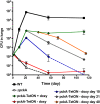Gluconeogenic carbon flow of tricarboxylic acid cycle intermediates is critical for Mycobacterium tuberculosis to establish and maintain infection
- PMID: 20439709
- PMCID: PMC2906907
- DOI: 10.1073/pnas.1000715107
Gluconeogenic carbon flow of tricarboxylic acid cycle intermediates is critical for Mycobacterium tuberculosis to establish and maintain infection
Abstract
Metabolic adaptation to the host niche is a defining feature of the pathogenicity of Mycobacterium tuberculosis (Mtb). In vitro, Mtb is able to grow on a variety of carbon sources, but mounting evidence has implicated fatty acids as the major source of carbon and energy for Mtb during infection. When bacterial metabolism is primarily fueled by fatty acids, biosynthesis of sugars from intermediates of the tricarboxylic acid cycle is essential for growth. The role of gluconeogenesis in the pathogenesis of Mtb however remains unaddressed. Phosphoenolpyruvate carboxykinase (PEPCK) catalyzes the first committed step of gluconeogenesis. We applied genetic analyses and (13)C carbon tracing to confirm that PEPCK is essential for growth of Mtb on fatty acids and catalyzes carbon flow from tricarboxylic acid cycle-derived metabolites to gluconeogenic intermediates. We further show that PEPCK is required for growth of Mtb in isolated bone marrow-derived murine macrophages and in mice. Importantly, Mtb lacking PEPCK not only failed to replicate in mouse lungs but also failed to survive, and PEPCK depletion during the chronic phase of infection resulted in mycobacterial clearance. Mtb thus relies on gluconeogenesis throughout the infection. PEPCK depletion also attenuated Mtb in IFNgamma-deficient mice, suggesting that this enzyme represents an attractive target for chemotherapy.
Conflict of interest statement
The authors declare no conflict of interest.
Figures





Similar articles
-
Triosephosphate isomerase is dispensable in vitro yet essential for Mycobacterium tuberculosis to establish infection.mBio. 2014 Apr 22;5(2):e00085. doi: 10.1128/mBio.00085-14. mBio. 2014. PMID: 24757211 Free PMC article.
-
PEPCK-M expression in mouse liver potentiates, not replaces, PEPCK-C mediated gluconeogenesis.J Hepatol. 2013 Jul;59(1):105-13. doi: 10.1016/j.jhep.2013.02.020. Epub 2013 Mar 4. J Hepatol. 2013. PMID: 23466304 Free PMC article.
-
Lactate oxidation facilitates growth of Mycobacterium tuberculosis in human macrophages.Sci Rep. 2017 Jul 25;7(1):6484. doi: 10.1038/s41598-017-05916-7. Sci Rep. 2017. PMID: 28744015 Free PMC article.
-
PCK1 and PCK2 as candidate diabetes and obesity genes.Cell Biochem Biophys. 2007;48(2-3):89-95. doi: 10.1007/s12013-007-0025-6. Cell Biochem Biophys. 2007. PMID: 17709878 Review.
-
[Hormonal control of the development of hepatic gluconeogenesis in the neonate].Ann Endocrinol (Paris). 1988;49(4-5):287-93. Ann Endocrinol (Paris). 1988. PMID: 3059968 Review. French.
Cited by
-
Novel inhibitors of cholesterol degradation in Mycobacterium tuberculosis reveal how the bacterium's metabolism is constrained by the intracellular environment.PLoS Pathog. 2015 Feb 12;11(2):e1004679. doi: 10.1371/journal.ppat.1004679. eCollection 2015 Feb. PLoS Pathog. 2015. PMID: 25675247 Free PMC article.
-
Nutritional metabolomics: progress in addressing complexity in diet and health.Annu Rev Nutr. 2012 Aug 21;32:183-202. doi: 10.1146/annurev-nutr-072610-145159. Epub 2012 Apr 23. Annu Rev Nutr. 2012. PMID: 22540256 Free PMC article. Review.
-
Succinylome analysis reveals the involvement of lysine succinylation in metabolism in pathogenic Mycobacterium tuberculosis.Mol Cell Proteomics. 2015 Apr;14(4):796-811. doi: 10.1074/mcp.M114.045922. Epub 2015 Jan 20. Mol Cell Proteomics. 2015. PMID: 25605462 Free PMC article.
-
A comparative lipidomics platform for chemotaxonomic analysis of Mycobacterium tuberculosis.Chem Biol. 2011 Dec 23;18(12):1537-49. doi: 10.1016/j.chembiol.2011.10.013. Chem Biol. 2011. PMID: 22195556 Free PMC article.
-
Mycobacterium tuberculosis: success through dormancy.FEMS Microbiol Rev. 2012 May;36(3):514-32. doi: 10.1111/j.1574-6976.2012.00331.x. Epub 2012 Mar 8. FEMS Microbiol Rev. 2012. PMID: 22320122 Free PMC article. Review.
References
-
- Harries AD, Dye C. Tuberculosis. Ann Trop Med Parasitol. 2006;100:415–431. - PubMed
-
- Boshoff HI, Barry CE., 3rd Tuberculosis—metabolism and respiration in the absence of growth. Nat Rev Microbiol. 2005;3:70–80. - PubMed
-
- Muñoz-Elías EJ, McKinney JD. Carbon metabolism of intracellular bacteria. Cell Microbiol. 2006;8:10–22. - PubMed
-
- Sauer U, Eikmanns BJ. The PEP-pyruvate-oxaloacetate node as the switch point for carbon flux distribution in bacteria. FEMS Microbiol Rev. 2005;29:765–794. - PubMed
Publication types
MeSH terms
Substances
Grants and funding
LinkOut - more resources
Full Text Sources
Medical
Molecular Biology Databases

